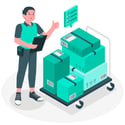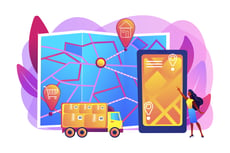E-commerce has seen steady growth over the past decade and is expected to continue evolving in 2024.
Dispatch Software Essentials: Understanding Key Concepts
The "today" of the logistical sector is a perfect blend of market demand, innovation, and technological adoption.

With customer-centricity becoming an integral part of operations, the logistics industry has shown a dynamic shift in handling market demands, embracing technology, and enabling growth in its operational processes. The raised bar of customer expectations has opened doors to numerous opportunities for growth and expansion for logistic providers in the market.
The "dispatch" process sits at the core of any logistic cycle. For any business to efficiently orchestrate its order-to-delivery phase, it must start with dispatch. Here's how, with the help of dispatch management software, businesses can make a notable difference in their fulfillment process.
Dispatch Software: Reshaping the Fulfillment Process
Dispatch software, by its definition, provides advanced solutions for analyzing, planning, and executing the journey of a parcel from the order stage to being out for delivery. This solution empowers operators to swiftly and effectively process orders while selecting the best route and fleet for seamless delivery.
The dispatch software is crucial in facilitating dynamic dispatches that meet elevated customer expectations while ensuring efficient resource utilization and optimally managing profit margins.
Related: Explore Dispatch Software Features
Transforming your Logistics: The Power of Dispatch Software
While numerous logistics companies have already embraced dispatch software to future-proof their fulfillment cycles, here's how existing users can maximize their potential and new users can adopt it in the changing times.
In this section, we've segmented it into three parts: the situation background (which encapsulates real-time scenarios within the fulfillment cycle); challenges, (which outline the scope of efficiency concerns); and finally, the solutions provided by Dispatch Software to address these challenges.
#1 Consolidate Orders
This stage involves the receipt of orders by dispatchers.
Background: Multiple orders in multiple formats from various sources are received at any fraction of time in this phase. There is no fixed time or single source to collect all these orders.
Challenges: In a manual setup, dispatchers continuously handle order capture, maintenance, and processing, which often introduces delays and errors due to the repetitive and tedious nature of the task.
Solutions: A dispatch management software automates order capture, consolidating orders from various sources into a predefined format, streamlining the process. Click here to read in detail.
#2 Select the Route
This involves selecting the most optimal and efficient route for swift delivery.
Background: Various orders are received, each needing delivery to its respective recipient at a different address. To facilitate this, dispatchers must determine the route and select the appropriate fleet for each order out for delivery.
Challenges: Creating a route plan involves considering multiple parameters like road conditions, traffic congestion, peak hours, and external factors such as road permits or potential vehicle breakdowns. Dispatchers need to prioritize selecting the fastest route to ensure timely deliveries when faced with shorter delivery windows.
Solutions: An effective route optimization feature within dispatch software can generate an ideal route plan, enabling multiple deliveries in a single trip. This functionality empowers dispatchers to strike a balance between increasing parcel deliveries and ensuring optimal resource efficiency.
Also Read: Types of Routing
#3 Get 360 Visibility 
It offers real-time visibility of all ongoing tasks, regardless of their delivery stage.
Background: As the number of simultaneous deliveries rises, dispatchers need to closely monitor the status of tasks in progress. Any disruption to the planned process can result in delays within the fulfillment cycle.
Challenges: Dispatchers must ensure proactive responses to any delays or disruptions in the plan. This necessitates maintaining visibility into the current task progress to swiftly address emerging situations.
Solutions: Dispatch software provides dispatchers with a comprehensive view of all tasks in progress. Dispatchers can oversee, track, and monitor ongoing tasks through a single screen. If there are any discrepancies, they can proactively make decisions to address issues as they arise.
#4 Real-time Communication
This involves real-time communication and connection with relevant stakeholders throughout the fulfillment cycle.
Background: Throughout the delivery orchestration, numerous stakeholders are involved. At different phases of the fulfillment cycle, these stakeholders need to connect to share updates or pass along crucial information related to the delivery cycle.
Challenges: Lacking streamlined communication can lead to delays or even postponements in deliveries. Additionally, stakeholders might miss time-sensitive information without an efficient communication system in place.
Solutions: Businesses utilizing dispatch software can harness real-time communication by providing delivery agents with a dedicated driver app. This app supports in-app communication, enabling drivers to stay informed and updated with real-time information crucial for their tasks.
#5 Make Informed Decisions
This phase involves reviewing and comprehending detailed reports for each stage of the delivery cycle.
Background: Each completed fulfillment cycle is valuable information for analyzing performance across various phases. Analyzing this performance and implementing the lessons learned in upcoming delivery cycles is crucial for optimizing operations.
Challenges: Relying on manual interpretations alone can be challenging for operators when understanding deliveries. Without timely insights, dispatchers might overlook implementing valuable learnings or insights into upcoming operational tasks of a similar nature.
Solutions: Dispatch software is equipped with built-in efficiencies that generate detailed and rapid reports on fulfillment performance. This empowers stakeholders to access insight-driven information and implement actionable insights into their upcoming operational tasks.
Navigating Growth in Logistics with DispatchOne
Each of the functionalities discussed can significantly optimize logistics operations, fostering innovation and profitability. Getting started with dispatch software enables businesses to build technology for optimal orchestration of their delivery cycles.
DispatchOne, powered by OS1, stands as an agile, customizable, and scalable dispatch software, revolutionizing the order-to-dispatch phase for a seamless fulfillment cycle. This new-age dispatch management solution caters to enterprises and small businesses, automating their dispatching operations. It significantly reduces dispatch processing time, centralizes visibility, and streamlines driver operations, offering enhanced control. This impactful solution reduces operational costs and ensures scalability, enabling businesses to expand effortlessly through streamlined dispatch operations. Get in touch with experts to know more about DispatchOne.



